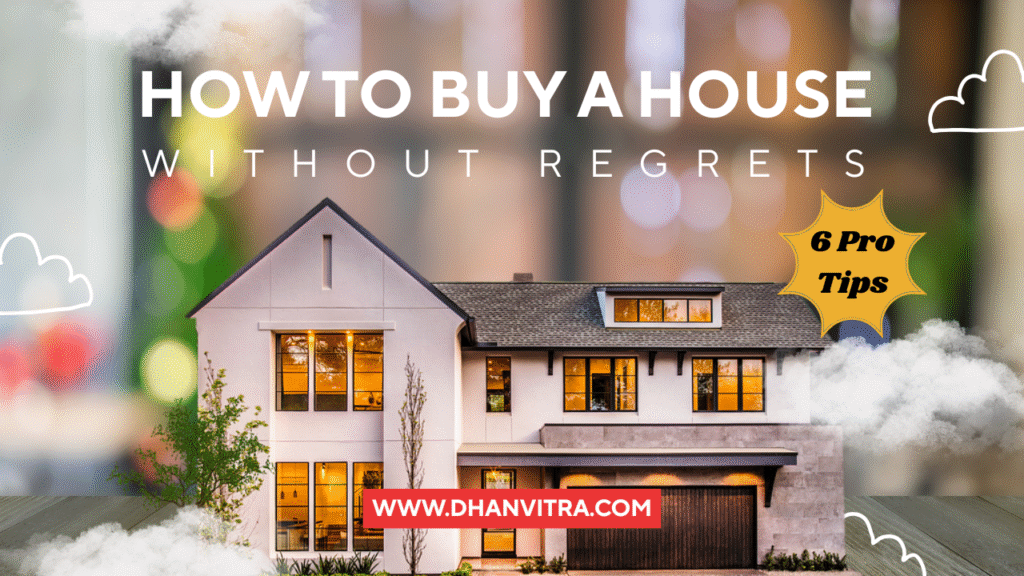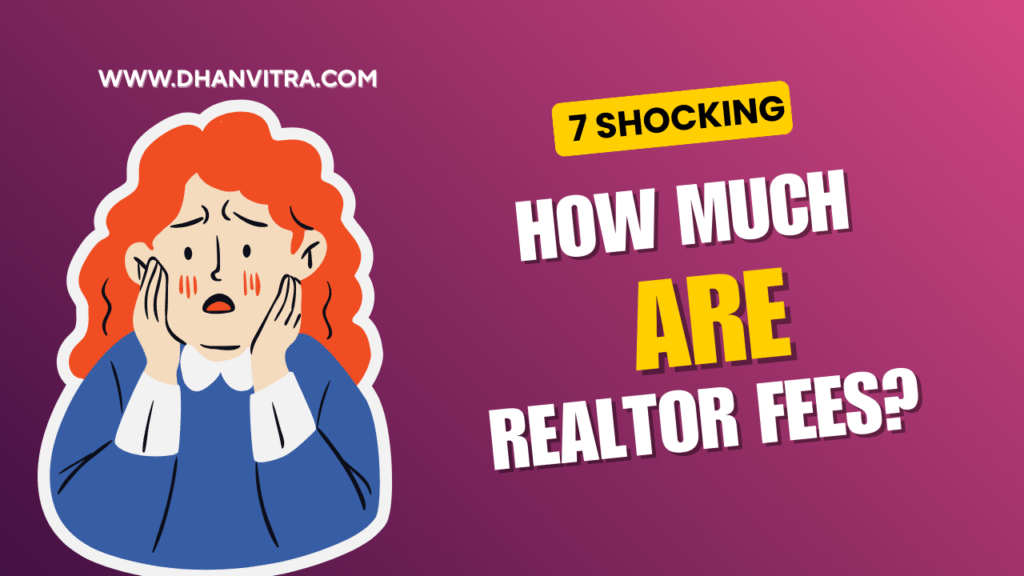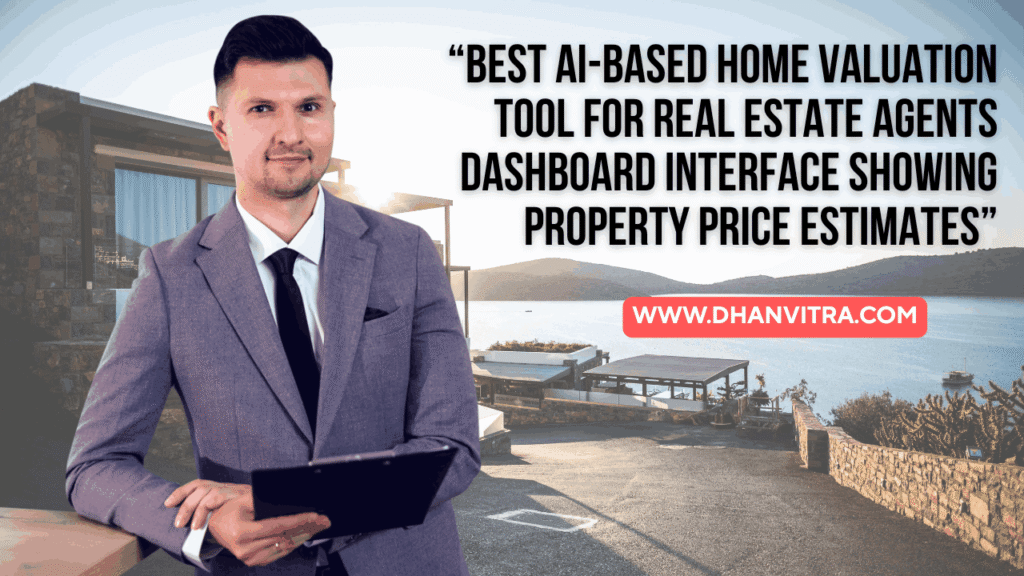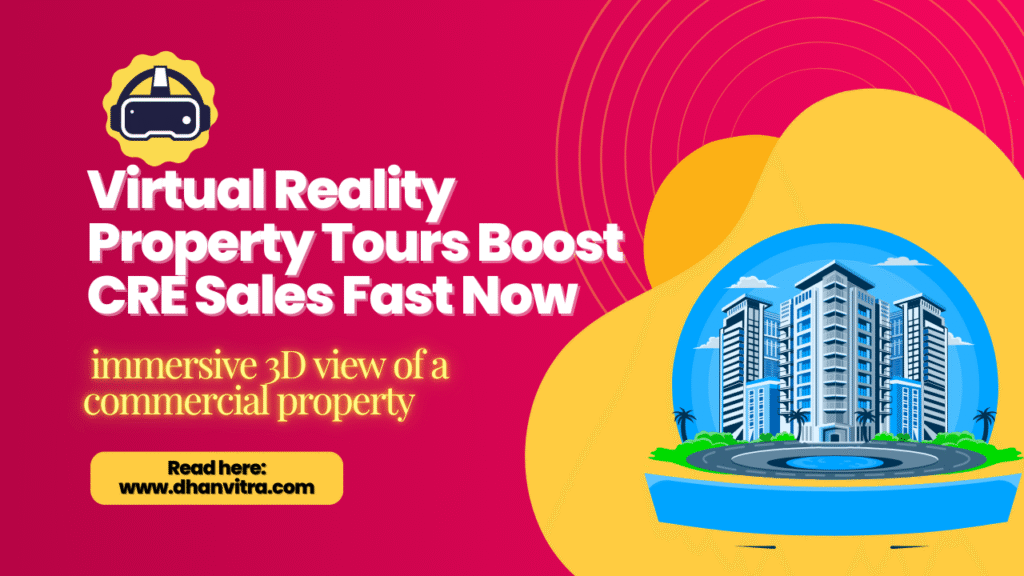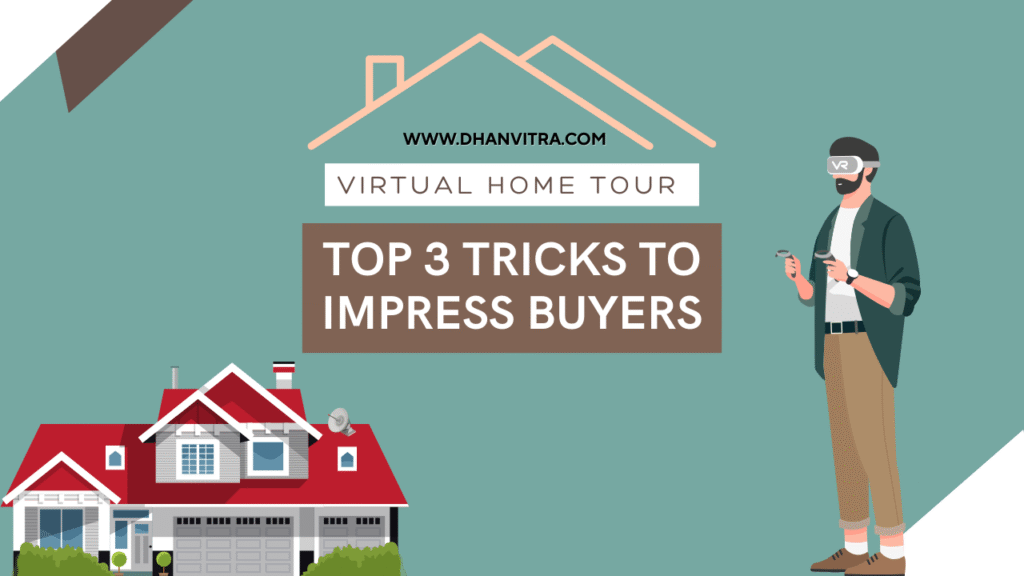
At Dhanvitra, we’re passionate about helping homeowners, realtors, and investors embrace the future of property showcasing. In today’s fast-moving real estate market, a first impression can make or break a deal — and that first impression often happens online. With virtual home tours, you can give potential buyers an immersive, 24/7 open house experience from anywhere in the world.
In this article, we’ll share “Virtual Home Tour: Top 3 Tricks to Impress Buyers”, a step-by-step guide to mastering this modern selling tool. You’ll learn how to stage your property digitally, leverage cutting-edge technology to make tours interactive, and create a powerful emotional connection with your audience. Whether you’re listing your first property or managing a portfolio, Dhanvitra is here to guide you through making your virtual tours irresistible.
Virtual home tours have evolved from being a “nice extra” into an expectation. In today’s digital-first marketplace, buyers expect to see a property online before deciding to view it in person. A virtual home tour goes beyond simple photos; it creates a 360-degree immersive experience where prospective buyers can explore every corner of a home at their own pace. This format appeals to buyers across the globe because it removes the limitations of geography, time zones, and travel costs.
When done correctly, a virtual tour functions like an open house that never closes. International investors or busy professionals can log in anytime to see the property. It also helps build trust — buyers feel you are transparent about what you’re offering. In a way, a virtual tour acts as your property’s “digital handshake,” setting the tone and helping you stand out in a crowded market.
A high-quality virtual tour also taps into the psychology of decision-making. People buy with emotions first and justify with logic later. When viewers see themselves living in the space, walking through hallways, or imagining their furniture in the living room, you’re already halfway to a sale.
Table of Contents
Trick 1 – Mastering Visual Presentation
Visual presentation is the heartbeat of any successful virtual tour. No matter how strong your property’s features are, poor presentation can sabotage its appeal. In a digital environment, buyers can’t touch or smell the space, so they rely solely on sight and sound. This makes it essential to get your visuals right the first time.
Start by staging your home digitally. Just like physical staging for an open house, digital staging adds warmth, style, and purpose to each room. Use neutral color palettes, minimal clutter, and tasteful décor that appeals to a wide audience globally. Remember, less is more — buyers need to imagine their own belongings in the space.
Lighting and angles are the hidden champions of your virtual tour. Natural light always works best because it creates a sense of openness and authenticity. Take photos and videos at the brightest time of day and make sure all rooms are evenly lit. Use wide-angle shots to capture entire rooms, but avoid distortion that makes spaces look unrealistic.
Quality visuals are non-negotiable. Grainy or pixelated images send a subconscious message of neglect or cheapness. Invest in a high-resolution camera or hire a professional photographer who understands real estate visuals. Pair these images with smooth 360° videos to make viewers feel like they’re actually walking through the property.
Consistency ties the whole presentation together. Your branding — whether it’s fonts, logos, or color tones — should feel uniform across your website, listing platforms, and marketing materials. A seamless look instills professionalism and builds confidence in your buyers.
Trick 2 – Leveraging Technology for Interactivity
Static photos are no longer enough. Modern buyers expect to interact with a property online just as they would in real life. This is where technology can transform your virtual tour from a passive slideshow into an active experience.
Start by adding floor plans with clickable hotspots. When a buyer can click on a bedroom and instantly “jump” to it in the virtual tour, they feel in control. This reduces frustration and keeps them engaged longer. Interactive features such as measuring tools or furniture placement previews can help buyers plan their future in the space.
Integrating live video walk-throughs is another powerful move. Think of it as a FaceTime or Zoom tour — you guide potential buyers through the property in real time, answering their questions as they arise. This personal touch bridges the gap between virtual and in-person experiences, especially for international buyers who can’t easily attend an open house.
Virtual Reality (VR) and Augmented Reality (AR) add another dimension. With VR, buyers wearing headsets can immerse themselves fully in the property, while AR lets them overlay furniture, colors, or renovation ideas onto existing rooms. These technologies make your property memorable and increase perceived value because they show you’re ahead of the curve.
However, advanced features only work if your tour loads quickly. Large files can frustrate users, especially those viewing on mobile or with slower internet connections. Compress your images and videos without sacrificing quality and test your virtual tour across different devices and browsers to ensure a seamless experience.
Ultimately, technology should empower the buyer. The more they can click, explore, and visualize, the deeper their connection to the property becomes. Interactivity turns your virtual tour from a flat presentation into a living, breathing experience that can close deals faster.
Trick 3 – Creating a Story and Emotional Connection
When buyers view your virtual home tour, they’re not just looking at walls, floors, and ceilings — they’re imagining their life there. This is why creating a narrative is so powerful. Rather than simply showcasing empty rooms, use your virtual tour to paint a picture of how someone might live, work, and relax in that space. Show the morning sunlight spilling across the kitchen counter, or stage a home office setup that looks inviting and productive. These subtle touches help people envision themselves in the home, making it more than just another property listing.
Adding a guided narration or background audio can deepen that emotional connection. A friendly voice introducing each room or highlighting unique features gives buyers the feeling of being personally walked through the space. This personal touch humanizes the experience, making it more memorable and persuasive. It’s like telling a mini story about the home — how the living room is perfect for hosting family dinners, or how the balcony could become a morning meditation spot.
Highlighting lifestyle rather than just square footage can also make your tour stand out. Instead of simply stating, “This is a three-bedroom apartment,” you could frame it as “A modern retreat with three restful bedrooms designed for privacy and comfort.” Emotions sell homes, and in a virtual environment, your story is the bridge between pixels and real-world feelings.
Additional Tips to Boost Buyer Confidence
Transparency builds trust, and trust leads to action. When creating a virtual home tour, don’t leave buyers guessing. Show clear pricing, updated availability, and easy ways to reach you directly from the tour page. This level of openness reassures potential buyers that you’re serious, accessible, and ready to answer their questions.
Providing downloadable brochures or spec sheets within your tour can also help buyers feel more secure. Think of it as leaving them with a digital “takeaway” — floor plans, measurements, or renovation details they can review later. It’s especially valuable for international buyers who may be comparing multiple properties across time zones.
Another often overlooked detail is privacy and security. Make sure the tour doesn’t accidentally reveal personal items or sensitive information. Blurring out family photos or removing valuable items from view ensures buyers focus on the property itself, not on personal belongings. This not only safeguards your privacy but also keeps the space feeling neutral and inviting.
Finally, optimize your virtual tour for mobile devices. In many parts of the world, people browse properties almost exclusively on their smartphones. A tour that loads quickly and displays beautifully on smaller screens instantly boosts buyer confidence and increases engagement.
Common Mistakes to Avoid
Poor-quality visuals are the quickest way to lose a buyer’s interest. If your photos are grainy or your video stutters, viewers will click away before even seeing the next room. Invest in professional-level photography or virtual staging software to ensure every frame feels polished and intentional. A property shown poorly online rarely gets a second chance.
Another common error is overwhelming buyers with too much content. It can be tempting to add every detail you can think of, but endless clickable icons or pop-ups can feel cluttered and frustrating. Instead, focus on quality over quantity — only include details that matter most to your target audience.
Many sellers also forget about mobile optimization. In today’s global market, a significant percentage of buyers view listings on their phones or tablets. If your tour takes forever to load or doesn’t display correctly, you’re losing a huge portion of your audience. Ensuring your virtual tour is light, responsive, and visually clear on any device keeps potential buyers engaged longer.
Lastly, outdated information can undermine your credibility. A tour featuring old photos or inaccurate pricing signals to buyers that you’re not keeping up. Regularly update your virtual tours with the latest visuals, descriptions, and contact details to maintain trust and show professionalism.
Future of Virtual Home Tours
Virtual home tours aren’t just a passing trend—they’re reshaping the real estate market globally. In the future, you won’t simply scroll through flat images or choppy videos; you’ll experience properties as if you’re physically there, no matter where you live. Technology is evolving fast, and it’s turning virtual tours into a dynamic, interactive experience.
One of the biggest shifts will be AI-driven personalization. Imagine logging onto a real estate site and the tour instantly adapts to your preferences. If you’ve been searching for large kitchens or ocean views, the system could highlight those areas first, creating a custom experience for every potential buyer. This isn’t science fiction anymore—it’s already happening in early forms.
Another trend is real-time feedback integration. Buyers will soon be able to leave comments or questions as they’re exploring a property, and sellers or agents could respond live. Think of it as a virtual open house where conversations happen instantly, regardless of time zones. This will especially help global buyers who can’t attend live tours but still want answers on the spot.
The rise of mixed reality (AR and VR) will also be a game-changer. With VR headsets becoming cheaper and more portable, buyers could virtually “walk” through multiple properties in a single afternoon, adjusting finishes or furniture as they go. AR overlays could let them see the same space with different color schemes, flooring options, or even potential renovations. This level of immersion makes decision-making faster and far more informed.
Finally, hyper-realistic 3D modeling will give buyers a crystal-clear picture of every inch of the property. Instead of guessing room sizes or how sunlight hits a space at noon, they’ll be able to experience it in real-time simulations. This global accessibility levels the playing field, making it easier for international buyers to invest confidently without physically traveling to the property.
Conclusion
Virtual home tours have already rewritten the rules of real estate, but they’re only getting started. From AI-driven personalization to immersive VR experiences, the future promises a level of convenience and transparency that benefits everyone—buyers, sellers, and agents alike. If you’re selling your home today, you’re not just competing with local listings; you’re appealing to a worldwide audience with diverse expectations.
The key takeaway? Treat your virtual home tour as a living, breathing presentation of your property. Invest in quality visuals, use technology to create interactivity, and craft a compelling story around the lifestyle your home represents. When done right, a virtual home tour isn’t just a tool—it’s your most powerful sales pitch.
FAQs
What equipment is needed to create a virtual home tour?
You don’t need Hollywood-level cameras to make an impact, but you do need clarity and stability. A good DSLR camera or a high-end smartphone with a gimbal can capture smooth footage. Add a 360° camera for immersive shots, and consider editing software or a professional service to stitch everything seamlessly.
How long should an ideal virtual tour last?
Attention spans online are short. A well-crafted virtual tour should be long enough to showcase your property but short enough to keep buyers engaged. Typically, five to seven minutes for a video walkthrough or a smooth click-through 3D tour works best.
Can virtual tours replace in-person visits completely?
For many global buyers, virtual tours are the first step, not the last. While they can significantly narrow down choices, most buyers still prefer an in-person visit before closing a deal. However, for overseas investors or busy professionals, virtual tours can absolutely drive purchase decisions without a physical visit.
How can I make my tour stand out from competitors?
Focus on storytelling. Instead of just showing rooms, show how a buyer might live in them. Highlight unique features, add interactive elements like floor plans or clickable hotspots, and ensure smooth navigation on mobile devices. Professional narration or background music can also create an emotional connection.
Are virtual tours expensive to create?
Costs vary depending on quality and technology. DIY tours with a smartphone can be very affordable, while high-end 3D or VR tours may require professional services. Think of it as an investment: the better the tour, the more likely you are to attract serious buyers faster.

